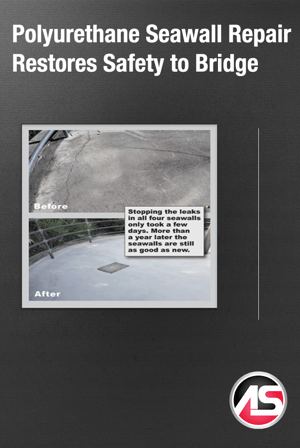
 Spanning the Pithlachascotee River in New Port Richey, Florida is the Madison Street Bridge. Built in 1985, this structure was buttressed with four semi-circular seawalls at the base of each footing in the year 2000.
Spanning the Pithlachascotee River in New Port Richey, Florida is the Madison Street Bridge. Built in 1985, this structure was buttressed with four semi-circular seawalls at the base of each footing in the year 2000.
Over the years, tide fluctuation caused soils to wash out from underneath the seawalls. This caused the heavily used sidewalks on top of the walls to crack and settle, allowing even rainwater in. Without an alternate way for pedestrians to traverse the bridge, this structural problem quickly became a critical public safety issue.
Powerful Polymer
To rapidly address the problem a certified contractor relied on AP Fill 700 and its NSF 61-5 certification (approved for contact with drinking water). The rapid expansive properties of this semi-rigid hydrophobic resin made it the optimal solution for painlessly filling the voids that had developed in the seawall and stopping the erosion beneath the sidewalks.
Painless Procedure
To rapidly address the problem a certified contractor relied on AP Fill 700 and its NSF 61-5 certification (approved for contact with drinking water). The rapid expansive properties of this semi-rigid hydrophobic resin made it the optimal solution for painlessly filling the voids that had developed in the seawall and stopping the erosion beneath the sidewalks.
Rapid Result
Stopping the leaks in all four seawalls only took a few days. More than a year later the seawalls are still as good as new.


